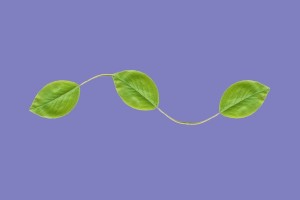Enter 550 — Marton’s “Cursive” Again
Marton got back to me about his “cursive” yesterday, giving me enough material for a full entry.
He pointed out the direction of the leaves is not consistent. I had not noticed it. Which is a good lead-in to one of my much-repeated dogmas: there’s more to every good poem, however seemingly simple, than even a good critic will find on his own. Marton believes that “the first and the second leaf are connected in a way which is not possible in nature.” Hence, for him, the poem is displaying “the surmounting (or appeasing) of that impossibility.” This is a reading in addition tomine, not a counter-reading since it is does not contradict my reading. (Dogma #2: there is more than one good reading of any good poem-but there is only one main reading–to which all the other readings must conform. That said, I read the change of the direction of the ellipsis to suggest oneleaf’s rebelliousness. It doesn’t want to be part of an ellipsis. Or, in my main reading, it it is eager for winter, and the other two leaves are not? as for the linkage of the leaves being impossible in Nature, I’m confused: I view their stems as touching. But is the image of a vine? These leaves don’t look like a vine’s leaves to me.
They don’t look like autumn leaves, as my main reading of the poem has it, either. But they are detached leaves, so can’t be summer or spring leaves.
Marton also reminded me that he had dedicated the poem to me. That, he added, “is an important piece of information.  ” I was being modest, but I see that the dedication actually is important, for it connects the poem to my series, “Cursive Mathemaku.” Thinking about that connection, I thought of something else to mention about the poem–the fact that cursive writing is personal. The Nature in the poem is not a machine typing out falling leaves but an individual writing a poem with her leaves.
” I was being modest, but I see that the dedication actually is important, for it connects the poem to my series, “Cursive Mathemaku.” Thinking about that connection, I thought of something else to mention about the poem–the fact that cursive writing is personal. The Nature in the poem is not a machine typing out falling leaves but an individual writing a poem with her leaves.
.
